
Tamiya 1/48 P-47D Thunderbolt
| KIT #: | 61086 |
| PRICE: | $52.95 |
| DECALS: | Two options |
| REVIEWER: | Tom Cleaver |
| NOTES: | Aeromaster 48-392 decals |

| HISTORY |
Johnny Godfrey’s Nightmare:
On September 22, 1943, John T. Godfrey, the middle of three brothers born in Canada to English parents, then raised in Woonsocket, Rhode Island, achieved his dream of being a fighter pilot when he arrived at Debden. Having been arrested twice by the FBI for violation of the Neutrality Act when he tried to cross to Canada to join the RCAF, he learned while in flight training of the death of his oldest brother Reggie when his ship was sunk; he became obsessed with avenging the brother he had adored and idolized. Arriving in England in early 1943, he transferred to the USAAF in April. Assigned to the 336th squadron, he roomed with Bob Wehrman, who had met him when both were in advanced training with the RAF; he later described Godfrey as being shy at first and a bit standoffish, but “Once you got to know him, he was one of the best. I felt fortunate to become his friend.”
Godfrey flew on the September 27 Emden mission as “Shirtblue Purple Eight” to element leader Don Gentile. The weather the 4th ran into over Germany was worse than forecast and they were recalled. Heading home on instruments at 25000ft, all eyes were on squadron leader “Mac” McColpin, “Shirtblue Purple One.” After several long minutes of this, Gentile succumbed to vertigo, and quickly went into the “dead man’s spiral.” While his P-47 “Donnie Boy” spiraled toward the cloud deck below, the inexperienced Godfrey - who had received the standard admonishment “stick to me like glue” - followed. Gentile recovered his spatial awareness and nosed down to break out of the spin, pulling out just above the cloud deck. He was amazed to see Godfrey still on his wing. Back at Debden, Gentile was effusive with his praise of Godfrey for doing something that wouldn’t have been expected of an experienced wingman and asked McColpin to assign Godfrey as his regular wingman. The two would go on to write a remarkable record in the group’s annals.
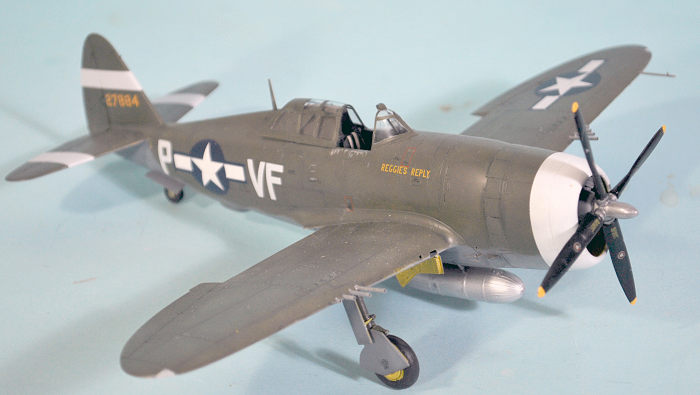 The new capability of the P-47 to provide longer-range
escort at high altitude had an unexpected effect on the pilots. Steve Pisanos
explained, “We were now regularly flying at 30,000ft for several hours, and the
missions only got longer as Technical Command developed the ability to carry
more drop tanks. Our unpressurized oxygen system was unchanged. It was good over
12,000ft, but over 24,000ft it wasn’t feeding as well as it did lower down, and
if anything happened to the system a man could pass out within a matter of a few
minutes and not realize anything was happening; by the time he came to, his
airplane was likely in a flat spin or a terminal velocity dive he wasn’t going
to get out of. After the war, the Air Force declared we had to have a
pressurized system for altitudes above 24,000ft. But we fought the whole war
with an oxygen system that really wasn’t giving us everything we needed up
there.”
The new capability of the P-47 to provide longer-range
escort at high altitude had an unexpected effect on the pilots. Steve Pisanos
explained, “We were now regularly flying at 30,000ft for several hours, and the
missions only got longer as Technical Command developed the ability to carry
more drop tanks. Our unpressurized oxygen system was unchanged. It was good over
12,000ft, but over 24,000ft it wasn’t feeding as well as it did lower down, and
if anything happened to the system a man could pass out within a matter of a few
minutes and not realize anything was happening; by the time he came to, his
airplane was likely in a flat spin or a terminal velocity dive he wasn’t going
to get out of. After the war, the Air Force declared we had to have a
pressurized system for altitudes above 24,000ft. But we fought the whole war
with an oxygen system that really wasn’t giving us everything we needed up
there.”
Godfrey would forever remember the mission of December 22 as the one that gave him nightmares for the rest of his life.
Group commander Chesley Peterson briefed at 0900hrs: the target was Münster, 300 miles inside Germany; it would be the deepest penetration mission the group had flown. The Eagles would provide withdrawal cover. The weather briefing was low clouds over England, heavy clouds over the North Sea, extensive clouds over most of the Continent, and especially heavy clouds over Münster. The bombers would drop using H2X blind bombing radar. The intelligence briefer announced the Luftwaffe now had more fighters stationed in Germany than ever before, and “opposition is assured.”
At 1237 hours, new 336th commander Major Selden Edner started his engine. Godfrey, flying Edner’s wing as “Shirtblue Purple Two,” goosed his Thunderbolt from its parking spot as Edner taxied past. At 1243hrs, they braked to a stop on the taxiway behind the 334th and 335th squadrons.
Once airborne, they sucked up gear and flaps, then banked left, circling the field with each pair cutting the turn a little tighter than the ones ahead to speed join-up. By the time Colonel Peterson completed two circuits, all 48 were in position. They continued climbing and each flight disappeared into the murk. Wingmen kept their eyes glued on their leader, formating as tight as possible, while they held “best climb.” 25minutes after takeoff, they were still in the soup when they crossed the unseen East Anglia coast and continued climbing over the North Sea. Everyone listened intently to their engine; should it fail, a man had 15 minutes in those waters to get in his life raft before he froze to death.
Finally, at 15,000 feet, the light inside the cloud grew brighter. The white-nosed fighters suddenly popped into the cold blue sky under a bright sun at nearly 17,000 feet. The enemy paid them no attention as they flew on toward Germany. Outside the cockpits, the air temperature was 40F below zero. Steve Pisanos recalled that under these conditions, “Your feet were about melting from the hot air pumped in from the engine, but by the time that air got to the control stick, you hand felt frozen around the grip.”
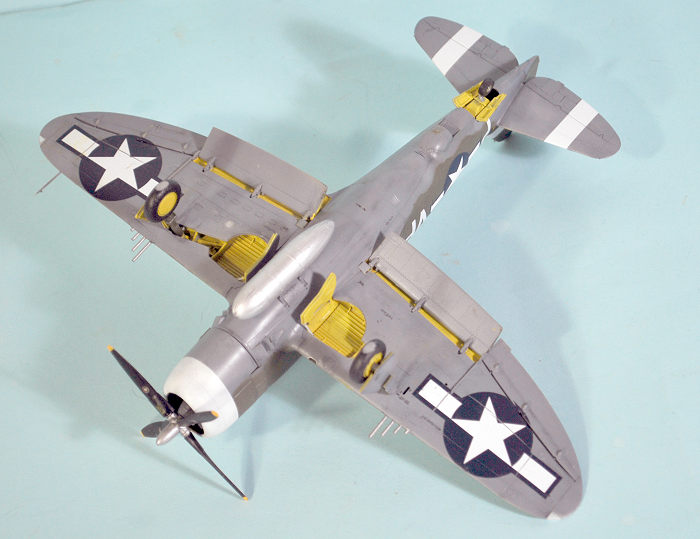 Finally, Münster hove into view. The sky was black with
flak bursts. Peterson sighted the lead bomber formation and led the 334th
squadron into position above the leading bombers, while the 335th moved to the
right around the formation’s middle and the 336th took up position on the left
rear.
Finally, Münster hove into view. The sky was black with
flak bursts. Peterson sighted the lead bomber formation and led the 334th
squadron into position above the leading bombers, while the 335th moved to the
right around the formation’s middle and the 336th took up position on the left
rear.
Godfrey would later be known as the pilot in the group with the best vision; he spotted two shadows racing across the cloud deck. In an instant, he spotted their source: two Bf-109s! He called them, Edner couldn’t see them. “Follow me! I’ll show ‘em to you!” Godfrey punched off his drop tank and winged over into a steep dive, failing to notice than no one followed.
He closed rapidly from behind unseen. His dive turned him away from the bomber’s course, taking him further into enemy airspace. Closing, he watched the two fighters just above the cloud tops. The wingman was higher and Godfrey chose him. He was closing so fast he pulled the throttle back almost to idle to cut his overtake speed. It wasn’t enough and he had time for only one burst as he roared past the surprised enemy pilot. The ‘109 was hit, but not enough to go down. As the enemy pilot turned to latch onto Godfrey’s tail, “Georgia” Wynn from the 334th squadron, who had heard Godfrey’s call and followed him down, pulled onto the 109's tail and opened fire. Godfrey rolled onto the tail of the leader before he could react. A solid burst set the engine on fire and smoke billowed from the cowling. An instant later, the canopy flew off and the pilot launched himself into space. The parachute billowed as Godfrey flashed past. He was exhilarated at the realization he’d scored victory number two.
Suddenly, the Thunderbolt staggered under heavy cannon hits. Godfrey looked in his rearview mirror, and saw a third 109 on his tail, spitting fire. Hit again, Godfrey pulled the stick back to his stomach and stomped the right rudder pedal, attempting to flick roll out of the line of fire. Instead, the P-47 flipped tail over nose, tumbling into the clouds below.
Now in a life-or-death battle to regain control of the violently-spinning fighter, he was thrown around the cockpit despite being strapped in. There was only one option left: bail out. But G-force threw him back into his seat each time he tried to grab the canopy handles to slide it open. Time seemed to slow as his body filled with adrenaline from the terror of dying. In a moment’s clarity, Godfrey suddenly thought to grab the throttle and stick and push them both forward. As speed increased, the violent shaking stopped and he was able to execute a successful spin recovery, greying out under the G-force as the P-47 nosed up.
When he glanced at the instrument panel, he saw it had been shot out. There was no attitude indicator and the ball was no longer in the turn and bank indicator. The airspeed indicator seemed to function and the magnetic compass was still OK. Inside the cloud, he had no idea if he was upright or inverted. Suddenly, the Thunderbolt popped out the bottom of the clouds. Whatever his altitude, the ground was close! He throttled back and pulled the stick back as far as he could. G-force greyed him out, then the treetops flashed below as the Thunderbolt streamed thick contrails from its wingtips. Suddenly, he was surrounded by flak explosions.
Flying by instinct, Godfrey pushed the throttle forward and pulled the stick back, climbing desperately for the cloud base. In a moment, he disappeared back into the enfolding greyness. He concentrated on flying carefully, watching the altimeter closely to spot a dive from vertigo as quickly as possible. Suddenly, the airplane seemed to go faster, and then he felt the spin as G-force pinned him in his seat. A moment later, the P-47 again spun out of the clouds in a vertigo-induced dead-man’s spiral. He managed to pull out over the tree tops again. This time he remained in the clear as he roared on just above the trees. There was a town ahead, then suddenly there was more flak exploding close enough to toss him around. Godfrey turned east, then north, staying low, and left the flak behind; but this wasn’t the direction home.
Looking outside, he realized he was now over
Holland. A moment later, he suddenly found himself over a
Luftwaffe
airfield he hadn’t seen in the rain! Knowing they would send someone after him,
he again took refuge in the clouds, regardless of vertigo. Once inside, he kept
climbing. All he could do was watch the altimeter, which kept advancing for
several minutes. Then the needle started unwinding and he felt the buildup of
G-forces again! For a third time, the P-47 fell out of the c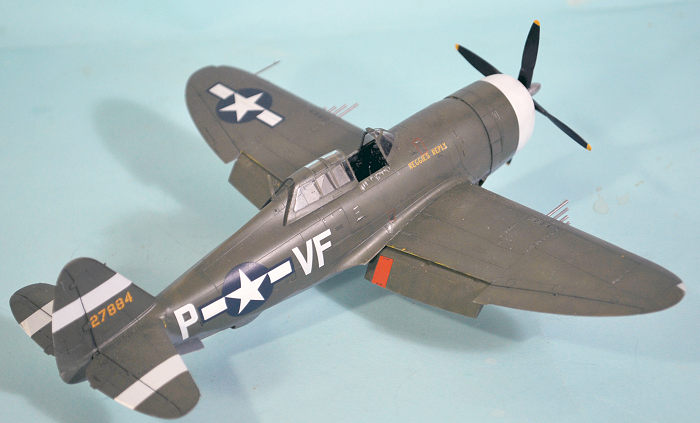 louds in a spin.
Desperately, he nosed down to get out of the spin, then pulled the stick back
hard and contrails from the wingtips drew a line that only flattened just above
the trees when he blacked out for an instant. Now thoroughly terrified,
Godfrey’s flying gear was sweat-soaked clear through. He stayed on the deck,
heading toward the coast.
louds in a spin.
Desperately, he nosed down to get out of the spin, then pulled the stick back
hard and contrails from the wingtips drew a line that only flattened just above
the trees when he blacked out for an instant. Now thoroughly terrified,
Godfrey’s flying gear was sweat-soaked clear through. He stayed on the deck,
heading toward the coast.
Again, flak bursts blossomed around him. There was a line of flak towers ahead and he could see the flashes of gunfire. His fear of being shot down overpowered the fear of vertigo and he climbed back into the clouds, reasoning he only had a few minutes to fly in them to get past the coastal flak belt. Again, he strained to watch the slightest movement of the altimeter, and moments later felt the unmistakable G-force of another vertigo-induced spin.
When he came out, he saw the North Sea below. The prop blast traced a line on the water as he pulled out mere feet above the waves. He steadied the compass and took up a 260-degree heading. The radio was out, wrecked by gunfire, so calling Air-Sea Rescue was impossible. The P-47 droned west, just above the waves of the rainswept North Sea. Godfrey leaned out the mixture till he heard the engine popping, then gave it just enough to keep it steady.
Finally, a smudge on the horizon resolved itself as England, but Godfrey had no idea where he was when he crossed the shoreline. Several minutes later, he came across an airfield he did recognize, Downham Market, west of Norwich, north of the Wash. He lowered flaps and dropped his gear, which thankfully came down and locked, and made a straight-in approach, heedless of any other airplane. He touched down and rolled out, coming to a stop by the small RAF control tower. Switching off the engine, he sat in the silence a long moment, then slid the canopy open and climbed out. When his feet touched the grass, he was overcome with nausea and was throwing up when an RAF officer arrived a minute later. After downing a tumbler of Irish whiskey to steady his nerves in the tower and sitting still for half an hour, he went back out and looked his Thunderbolt over. There were bullet holes, but nothing serious. He told them he was going home.
Twenty minutes later, never flying above 1,000 feet, Godfrey set down on the Debden runway. In the Officer’s Club later, Colonel Peterson started to reprimand him for leaving the formation, then thought better of it and bought him a drink.
| THE KIT |
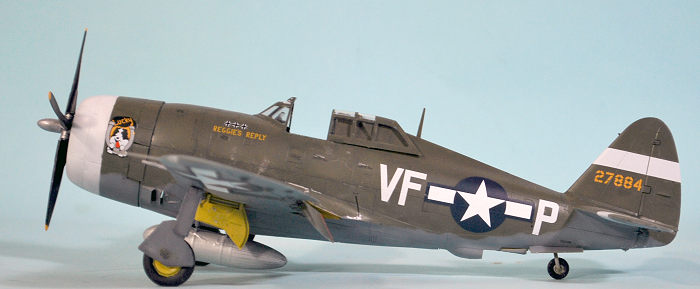 Tamiya first released the “razorback” version of the
P-47D in 2003, followed a year later by the “bubbletop” P-47D with a limited
release of the P-47M following. The kits were quickly recognized as being the
best P-47 kits in 1/48 and have maintained their popularity for their accuracy
and overall ease of assembly since.
Tamiya first released the “razorback” version of the
P-47D in 2003, followed a year later by the “bubbletop” P-47D with a limited
release of the P-47M following. The kits were quickly recognized as being the
best P-47 kits in 1/48 and have maintained their popularity for their accuracy
and overall ease of assembly since.
You can get these kits on Amazon now for $39.00 with free Prime delivery the next day. Since I can resist everything but temptation, my Thunderbolt air force is growing; especially when I found Aeromaster 48-392 “4th Fighter Group - The Early Days Part III” with the decals for “Reggie’s Reply” at EvilBay while writing the P-47 Bookazine for Key Publishing after finishing the manuscript for the coming “Clean Sweep: VIII Fighter command vs the Luftwaffe 1942-45" (publishing next May - the source of the story above).
| CONSTRUCTION |
Let’s face it, the Tamiya P-47 is the equivalent of a hot dog with sauerkraut and mustard, and a bottled-in-Mexico Coca-Cola (original recipe - no corn syrup): you know there aren’t going to be any surprises and that you’re going to like it. The kit is “modeling comfort food.”
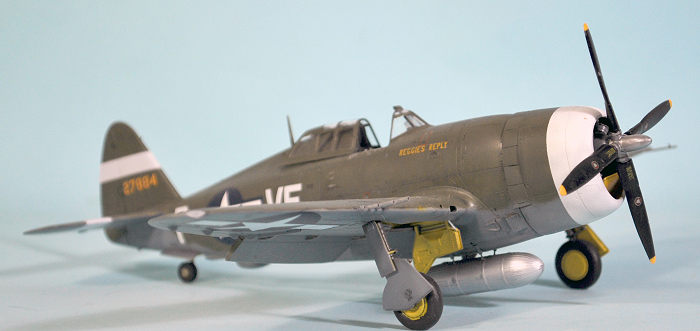 “Reggie’s
Reply” is identified as a P-47D-1, so the first thing to do was modify the
cowling flaps so they are all equal size. I chose to do the “closed flaps”
option for the kit, so used the “open flaps” and cut off two sets of two flaps,
bending them to fit a different position on the cowling, and replaced the two
lower flaps on the close option part.
“Reggie’s
Reply” is identified as a P-47D-1, so the first thing to do was modify the
cowling flaps so they are all equal size. I chose to do the “closed flaps”
option for the kit, so used the “open flaps” and cut off two sets of two flaps,
bending them to fit a different position on the cowling, and replaced the two
lower flaps on the close option part.
I paint all the details while the parts are still on the sprue trees: wheel wells, cowling interior, gear doors in Yellow zinc Chromate (a mixture of 90% Tamiya XF-3 “Flat Yellow” and 10% Tamiya XF-4 “Yellow Green”); Engine with Tamiya XF-16 “Flat Aluminum” and XF-53 “Neutral Grey;” cockpit with Tamiya XF-27 “Black Green.” For an early P-47D I use Tamiya XF-81 “RAF Cark Green” for the main gear legs, since they were painted “green base” OD-41, which is an exact match for RAF Dark Green since both paints used the same World War I “PC-10" specifications.
Past that, read the instructions, take care in assembly, and you will not use any filler anywhere. I chose on this model to put the flaps down, though P-47s are rarely on the ground in this configuration after touchdown.
| COLORS & MARKINGS |
I started by painting the white nose and masking it off, then pre-shading the model with Tamiya XF-1 “Flat Black.” The upper surfaces were painted with my mixture for “high altitude faded green base OD-41,” which is done with a mixture of Tamiya XF-81 “RAF Dark Green,” with each pass after the overall coat modified with “XF-52 Flat Earth,” “XF-3 Flat Yellow,” “eyeballed” to the shade desired and then lightened in later passes with XF-19 “Sky Grey” and a few drops of X-16 “Purple” to get the look of “high altitude UV sun fading,” which is how airplanes in the generally-cloudy ETO should look. The lower surfaces were painted with XF-53 “Neutral Grey.”
 I used the Aeromaster decals for the large lower wing
national insignia, and Fundekals national insignia for the fuselage nd upper
wing, with the Aeromaster sheet for the individual aircraft markings. I used the
Tamiya decals for the white ID stripes on the tail.
I used the Aeromaster decals for the large lower wing
national insignia, and Fundekals national insignia for the fuselage nd upper
wing, with the Aeromaster sheet for the individual aircraft markings. I used the
Tamiya decals for the white ID stripes on the tail.
After the decals had set, I gave the model an overall coat of MicroScale “Satin” to represent the slightly-polished look of 4th FG P-47s, which were all polished with beeswax (which the ground crews hated because it was time consuming to apply and made the airplane slick enough to fall off).
I assembled and attached the landing gear, then the drop tank rack (so as not to break it since it is fragile) and then a 108-gallon tank from the kit that I cut off the locating tab. The Fourth didn’t get all their P-47s equipped with the field kit for the underwing pylons till January 1944, so I only used the one tank and left off the pylons. I then attached the prop and posed the canopy open and called it done.
| CONCLUSIONS |
Tamiya P-47s are a perfect kit for someone returning to the hobby, since they are easy to assemble and practically guarantee a good result for anyone who takes the revolutionary act of reading and following the instructions. They’re also wonderful for anyone else, since they are so well designed, allowing a modeler to concentrate on finish and markings. You can’t go wrong with one of these kits.
24 November 2022
Copyright ModelingMadness.com. All rights reserved. No reproduction in part or in whole without express permission.
Review kit courtesy of my wallet.
If you would like your product reviewed fairly and fairly quickly, please contact the editor or see other details in the Note to Contributors.